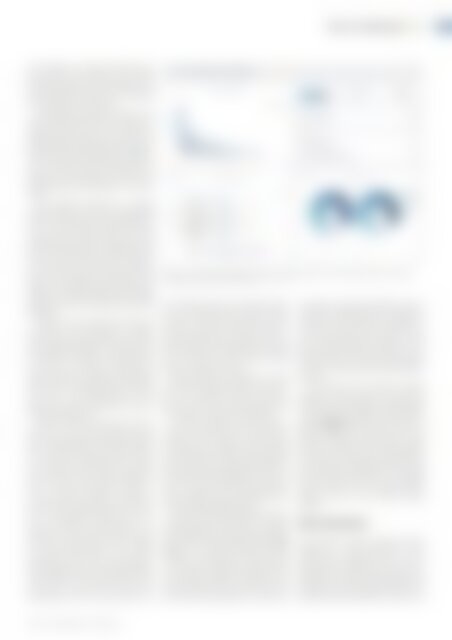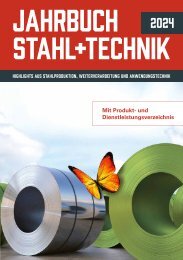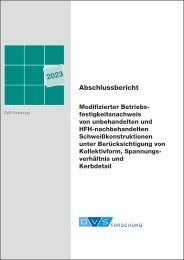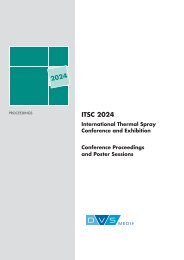STEEL + TECHNOLOGY 04/2019 EXTRACT
STEEL + TECHNOLOGY 04/2019 EXTRACT
STEEL + TECHNOLOGY 04/2019 EXTRACT
Create successful ePaper yourself
Turn your PDF publications into a flip-book with our unique Google optimized e-Paper software.
<strong>STEEL</strong> <strong>TECHNOLOGY</strong> | 65<br />
Figure 2. The SST Training Set Explorer can be used to create high-quality and representative<br />
training and test sets (Picture: SST)<br />
ative images of all relevant defect types<br />
are required. The classifier is then trained<br />
using the images in the training set, and<br />
the classification performance is validated<br />
by the images in the test set.<br />
Individual surface defect types on hot<br />
and cold rolled strips come in a variety of<br />
shapes and structures. At the same time,<br />
disparate defect categories (e.g. shells and<br />
scratches) sometimes have similar appearances<br />
and visual characteristics. Additionally,<br />
if individual variants (subclasses) are<br />
missing in the training set, they are not<br />
reliably learned and detected by the classifiers.<br />
The physical appearance of defect<br />
images depends on many metallurgical<br />
factors. One example is the steel grade of<br />
a coil, which directly affects the visual<br />
characteristics of both the steel surface<br />
and the actual defects. Additionally, factors<br />
such as the environmental conditions<br />
of the cameras (e.g. dampness, condensation,<br />
dirt) may affect the visibility of the<br />
defect in the images. Ideally, each defect<br />
category should be represented by images<br />
captured in each of these environmental<br />
variations.<br />
Another important aspect of training set<br />
construction is the selection of images<br />
over an extensive production period. A typical<br />
confounding effect is a concentration<br />
of images for a defect category among<br />
only a few coils. When a classifier is<br />
trained using this unbalanced and biased<br />
data, there is a danger that the classifier<br />
will “learn” the characteristics of the<br />
defect only within the specific context of<br />
the few sampled coils.<br />
When training and test sets are sampled<br />
from an overly-homogenous data<br />
set, the validation accuracy of the classifier<br />
on the test data is artificially inflated.<br />
If for example, exceptional visual cases<br />
are missing in the training set, the classifier<br />
will have never been exposed to<br />
them. One way to mitigate this effect is<br />
to use random samples of images for<br />
both the training set and test set. However,<br />
this naive randomization may introduce<br />
unintended consequences. For<br />
example, if in this random scheme a classifier<br />
is by chance only shown oil flecks<br />
on certain steel grades, it may naively<br />
associate oil stains with visual characteristics<br />
related only to those steel grades.<br />
The classifier would also perform artificially<br />
well on such a test set since the<br />
training set and test set would be randomly<br />
sampled from the same base dataset.<br />
This phenomenon poses a major<br />
problem in practice. Real-world cases of<br />
training set and test set splits have produced<br />
classification accuracies of up to<br />
80% using only the metadata associated<br />
with the defect image, such as steel<br />
grade and production time.<br />
Even though the classifiers in these<br />
examples may achieve high accuracy levels<br />
in the validation phase, this performance<br />
will fail to be reproduced under<br />
real, long-term production conditions.<br />
Last but not least, the size of the training<br />
set is a decisive factor for classification<br />
accuracy. Yet, in practice, many training<br />
and test sets are relatively small. Investing<br />
time and effort to create a large dataset is<br />
always worthwhile, especially when modern<br />
classifier technologies are used, as<br />
they can capture both the large variance<br />
within classes and the subtle differences<br />
between different defect types.<br />
Smart Steel Technologies has developed<br />
several software tools for properly<br />
creating effective training sets and test<br />
sets. The SST Training Set Optimizer (figure<br />
2) is a statistical analysis tool that<br />
monitors the composition of training sets<br />
and test sets, enabling the efficient addition<br />
of defect images. In addition to the<br />
class distribution, the chosen production<br />
period and steel grades per class can be<br />
monitored. A train-test correlation is automatically<br />
calculated based on metadata.<br />
Instead of evaluating the datasets by<br />
naive statistics (e.g. total number of images),<br />
a comprehensive overview of the<br />
training set and test set condition is presented<br />
instead, including potential steps<br />
to take for improvement of classification<br />
systems.<br />
To quickly find and identify suitable<br />
images to training sets and test sets,<br />
Smart Steel Technologies has developed<br />
a deep learning based image search<br />
engine (figure 3) that allows millions of<br />
defect images to be searched for visual<br />
similarity in fractions of a second. Using<br />
the built-in filters for specific steel grades<br />
and production periods, hundreds of images<br />
can be found and added to the training<br />
or test set within a few hours. The image<br />
search effectively finds suitable defect<br />
images even for the rarest surface<br />
defects.<br />
Defect distributions<br />
There exists a natural, significant class<br />
imbalance in steel production: some<br />
defect image categories such as pseudo-defects<br />
or superficial dirt occur very<br />
frequently, while more severe defects are<br />
relatively rare. Classification systems must<br />
be able to effectively identify the few truly<br />
<strong>STEEL</strong> + <strong>TECHNOLOGY</strong> 1 (<strong>2019</strong>) No. 4


















